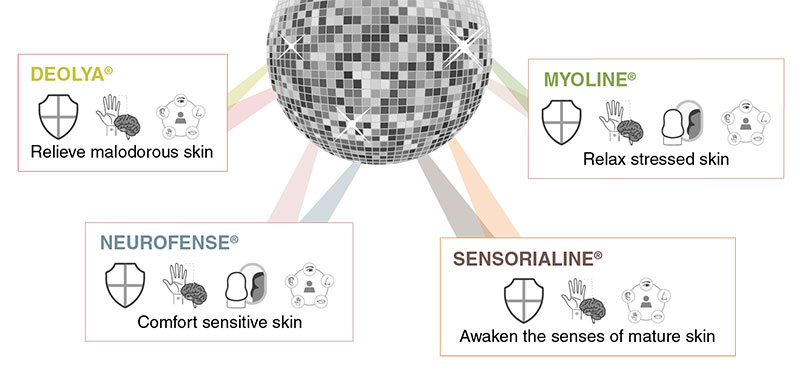The skin: a shield
A true protector of the human body, the skin is a vital organ that is both a permeable and impermeable boundary between the body and the environment surrounding it. Its vulnerability results from its thinness, while its suppleness provides it with a remarkable capacity for
modification, transformation and adaptability. It symbolizes the dynamism of constant renewal via the phenomenon of keratinization. Its shape, texture, color and scars all bear witness to what it has gone through and to disturbances to its biological homeostasis. As the site of exchanges and contacts with the exterior, the skin breathes, perspires, eliminates, metabolizes, secretes, absorbs and is also an important go-between for the brain.
The skin: a brain’s extension
During the 21 st day of human embryo development, the most external cell layer gives rise to both the nervous system and the most superficial layer of the skin, the epidermis. The shared origin of these two structures explains the similarities between neurons and skin cells, as well as the primordial role of this brain’s extension in identity construction.
The skin is richly innervated by a network of sensory fibers and exchanges with the brain numerous stimuli perceived, using a common language characterized by the expression of identical mediators and receptors.
The skin: a mirror of emotional state
Often described as the mirror of the soul, the skin and in particular that of the face, expresses emotions that we would prefer to keep secret: anger, sadness, disgust or fear. The impact of stress on the skin causes tension of the facial muscles responsible for the formation of characteristic wrinkles. The skin is also the site of secretions of stress mediators that result in a deterioration of the barrier function and of complexion radiance.
Inversely, in the case of a pleasant tactile experience, the skin sends a positive message to the brain causing it to release oxytocin. This boosts the sensation of well-being at the same time as attenuating fear. At the level of the skin, the barrier function is reinforced.
The skin: a sensory cocoon
The skin has an exceptional memory and remains in constant connection with other sensory organs involved in hearing, sight, taste and smell. The sense of smell is the most primitive since it acts as a primordial identity vector in our socio-cultural interactions. In this context, the nature and activity of the microflora living on the surface of the skin forms a unique olfactory envelope proper to each person. The sense of smell is also an important emotional trigger intimately bound to that of taste.
It is surprising to see that olfactory and taste receptors have been demonstrated in the epidermis, where they modulate epidermal regeneration. The skin has therefore been shown to be an extraordinary enhancer of the senses and uses them in a surprising way to boost its force and beauty.

Figure 1. The different metaphors of the skin
In order to be in harmony with the multiple faces of the skin - a powerful physical boundary, a genuine partner of the brain, the mirror of our emotional state as well as a sensorial ally - SILAB proposes a selection of four highly performant multi-facet active ingredients.
Comfort sensitive skin
SILAB got interested in red sage, a plant used in traditional Chinese medicine and recognized for its elevated capacity to resist low temperatures, to develop a natural active ingredient that treats the discomfort of sensitive skin. For the first time the three biological components involved in cutaneous sensitivity are targeted: neuronal hyper-reactivity, quality of the cutaneous barrier
and inflammation of the skin.
Tested in Caucasian and Asian panels, its efficacy provides comfort and protection to sensitive skin that reacts excessively to external stimuli. In vivo, the soothing efficacy of NEUROFENSE® has been shown in extreme situations. It increases the reactivity threshold of skin in conditions mimicking a winter climate and also reduces sensitivity to pollution.
Relax stressed skin
Minerals are known to regulate muscle contraction and cell signaling linked to receptors of well-being. After extensive screening, SILAB focused on the mineral richness of watercress to develop a relaxing active ingredient targeting the consequences of stress on the skin.
As of 5 days, MYOLINE® increases oxytocin secretion in young and mature volunteers. Older subjects perceive a reduction in their stress level and their barrier function is strengthened, resulting in durable hydrating and radiance-boosting effects. This mineral concentrate acts as a genuine plant-derived “botox-like” agent, attenuating expression wrinkles as of 5 days of use by young and mature panels. In addition, an original study has shown its “soft focus” effect, with a result similar to that obtained with a retouched photo.
Relieve malodorous skin
When studying the biological mechanisms responsible for the appearance of axillary unpleasant odors, SILAB demonstrated by metasequencing an increased relative abundance of Staphylococcus hominis and of the enzymatic activity causing the appearance of thiols in malodorous volunteers compared to a non-odorous panel.
By targeting the mechanisms involved in the production of odors while respecting the axillary skin physiology, DEOLYA® limits perspiration odors by acting on the bacteria responsible for these odors and soothes underarm irritations. The deodorant and soothing efficacy of the active ingredient comes from the unique polyphenolic profile obtained by SILAB from meadowsweet.
Awaken the senses of mature skin
In order to further understand the concept of skin sensoriality, SILAB used in vitro biological models and showed that these epidermal receptors became deregulated in the course of aging.
The coconut is a tasty tropical fruit with both olfactory and taste sensoriality and SILAB identified active molecules in this fruit that can precisely target epidermal sensory receptors. These molecules were isolated using a patented eco-extraction process. SENSORIALINE® activates these epidermal sensorial receptors deregulated in the course of aging, awakens the senses, favors cutaneous regeneration and guarantees maintaining a robust and effective barrier function over time. This natural active ingredient boosts skin hydration and significantly revives its radiance. The skin is visibly smoother, more moisturized and more comfortable.

Figure 2: Selection of multi-facet active ingredients for the beauty and health of the skin
With its "Skin Metaphors" theme, SILAB is once again drawing on its expertise in cutaneous biology to enable the skin to achieve the most beautiful version of itself.

